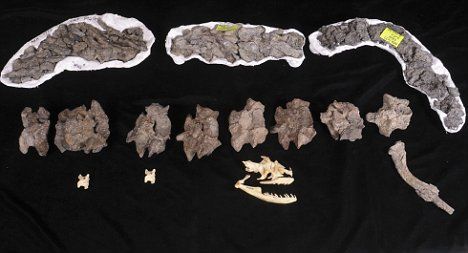"Now we have a window into the time just after the dinosaurs went extinct and can actually see what the animals replacing them were like," he noted.
 |
|
An undated handout image from the British science magazine Nature shows the vetebrae of the world's biggest snake with the vertebrae (in white) of a modern 17 foot Anaconda. The report said that the boa-like behemoth ruled the tropical rainforests of what is now Colombia some 60 million years ago.
|
Size does matter because the snake's gigantic dimensions are a sign that temperatures along the equator were once much hotter. That is because snakes and other cold-blooded animals are limited in body size by the ambient temperature of where they live, Bloch said.
"If you look at cold-blooded animals and their distribution on the planet today, the large ones are in the tropics, where it's hottest, and they become smaller the farther away they are from the equator," he said.
Based on the snake's size, the team was able to calculate that the mean annual temperature at equatorial South America 60 million years ago would have been about 91 degrees Fahrenheit, about 10 degrees warmer than today, Bloch said.
The presence of outsized snakes and turtles shows that even 60 million years ago the foundations of the modern Amazonian tropical ecosystem were in place, he said.
(Xinhua News Agency February 6, 2009)